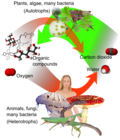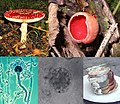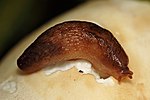A heterotroph (/ˈhɛtərəˌtroʊf, -ˌtrɒf/; from Ancient Greek ἕτερος (héteros) 'other', and τροφή (trophḗ) 'nutrition') is an organism that cannot produce...
27 KB (2,935 words) - 20:11, 6 April 2024
Myco-heterotrophy (redirect from Myco-heterotrophs)
food from parasitism upon fungi rather than from photosynthesis. A myco-heterotroph is the parasitic plant partner in this relationship. Myco-heterotrophy...
16 KB (1,531 words) - 21:13, 24 May 2024
Phototroph (redirect from Phototrophic heterotroph)
energy currency for the cell. Phototrophs can be either autotrophs or heterotrophs. If their electron and hydrogen donors are inorganic compounds (e.g....
8 KB (737 words) - 01:11, 6 August 2023
Carbon source (biology) (section Heterotrophs)
organism to synthesise biomass. Such sources may be organic or inorganic. Heterotrophs must use organic molecules as a source of both carbon and energy. In...
2 KB (479 words) - 09:12, 5 January 2024
Chemotroph (redirect from Chemotrophic heterotroph)
as a synonym of chemoautotrophy. Chemoheterotrophs (or chemotrophic heterotrophs) are unable to fix carbon to form their own organic compounds. Chemoheterotrophs...
9 KB (829 words) - 02:51, 16 May 2024
that transfer energy in the anabolic processes of ATP synthesis (in heterotrophs) or biosynthesis (in autotrophs). The electron or hydrogen donors are...
19 KB (1,636 words) - 13:31, 17 June 2024
on 28 February 2018. Retrieved 25 February 2018. Bergman, Jennifer. "Heterotrophs". Archived from the original on 29 August 2007. Retrieved 30 September...
125 KB (11,192 words) - 01:44, 14 July 2024
cyanobacteria gather energy directly from sunlight by photosynthesis. Heterotrophs including all animals, all fungi, all completely parasitic plants, and...
137 KB (14,760 words) - 23:55, 11 July 2024
have formed a network of trophic relationships between autotrophs and heterotrophs, which are included in the stages of Lepidoptera larvae, pupae, and adults...
148 KB (16,831 words) - 07:35, 13 July 2024
and will be used as carbon and energy source by other organisms (e.g. heterotrophs and mixotrophs). The photoautotrophs are the main primary producers,...
19 KB (2,043 words) - 08:28, 7 July 2024
Geosiris aphylla is sometimes called the earth-iris. It is a small myco-heterotroph lacking chlorophyll and obtaining its nutrients from fungi in the soil...
2 KB (185 words) - 18:30, 14 September 2023
which are vital for other species within the ecosystem. Ecology portal Heterotroph Lithotroph Ecological pyramid Predator-prey interaction "The Food Chain"...
18 KB (2,039 words) - 08:38, 9 July 2024
some protists is chitin in their cell walls. Fungi, like animals, are heterotrophs; they acquire their food by absorbing dissolved molecules, typically...
201 KB (19,169 words) - 10:00, 9 July 2024
independently evolved various levels of endothermy. Bony fish can be any type of heterotroph: numerous species of omnivore, carnivore, herbivore, filter-feeder, detritivore...
32 KB (2,187 words) - 00:53, 11 July 2024
This mode of nutrition is also known as heterotrophic nutrition. All heterotrophs (except blood and gut parasites) have to convert solid food into soluble...
3 KB (216 words) - 06:15, 20 May 2024
building-blocks and in other synthetic pathways that allow the organism to grow. Heterotrophs, such as animals, use light from the Sun indirectly by consuming the...
52 KB (5,643 words) - 17:08, 25 June 2024
unites tortoises, snails and sponges. Being animals, invertebrates are heterotrophs, and require sustenance in the form of the consumption of other organisms...
44 KB (4,871 words) - 20:34, 2 July 2024
of thiobacilli and other sulphur-oxidizing autotrophs, mixotrophs and heterotrophs". Philosophical Transactions of the Royal Society of London. Series B...
98 KB (10,952 words) - 10:00, 21 June 2024
Ecologists can broadly define all life forms as either autotrophs or heterotrophs, based on their trophic levels, the position that they occupy in the...
83 KB (8,689 words) - 12:42, 6 June 2024
such as Armillaria, and saprotrophs. These orchids are known as myco-heterotrophs, but were formerly (incorrectly) described as saprophytes as it was believed...
60 KB (6,314 words) - 21:49, 24 June 2024
and symbiotic associations between chemosynthesizers and respiring heterotrophs are quite common. Large populations of animals can be supported by chemosynthetic...
12 KB (1,202 words) - 13:46, 26 June 2024
level are the heterotrophs, which are the species that obtain energy by breaking apart organic compounds from other organisms. Heterotrophs that consume...
132 KB (13,750 words) - 04:27, 23 June 2024
chemosynthesis. Heterotrophs are organisms that must feed on others for nourishment and energy (respiration exceeds production). Heterotrophs can be further...
210 KB (21,521 words) - 06:43, 12 July 2024
Monotropastrum humile, a myco-heterotroph dependent on fungi throughout its lifetime...
32 KB (3,727 words) - 17:56, 23 May 2024
golden algae, euglenids, dinoflagellates, and other algae have become heterotrophs (also called colorless or apochlorotic algae), sometimes parasitic, relying...
91 KB (10,509 words) - 15:43, 22 May 2024
plucheas, and Tiquilia plicata and T. palmeri to obtain nutrients. As a heterotroph, the Pholisma sonorae plant lacks chlorophyll and is grayish, whitish...
3 KB (286 words) - 11:52, 22 April 2024
emerged around 4 billion years ago. The first cells were most likely heterotrophs. The early cell membranes were probably simpler and more permeable than...
60 KB (6,271 words) - 20:47, 13 July 2024
migration Dimethylsulfoniopropionate f-ratio Fish diseases and parasites Heterotroph HNLC Macroalgae Manta trawl Marine mucilage Microbial mat Ocean acidification...
62 KB (6,475 words) - 00:04, 30 June 2024
compounds such as nitrate, sulfate, or carbon dioxide. Many bacteria, called heterotrophs, derive their carbon from other organic carbon. Others, such as cyanobacteria...
143 KB (15,529 words) - 14:55, 10 July 2024
structures. Organisms can be classified by how they obtain carbon and energy. Heterotrophs are organisms that obtain nutrients by consuming the carbon of other...
36 KB (3,995 words) - 16:58, 10 July 2024
























